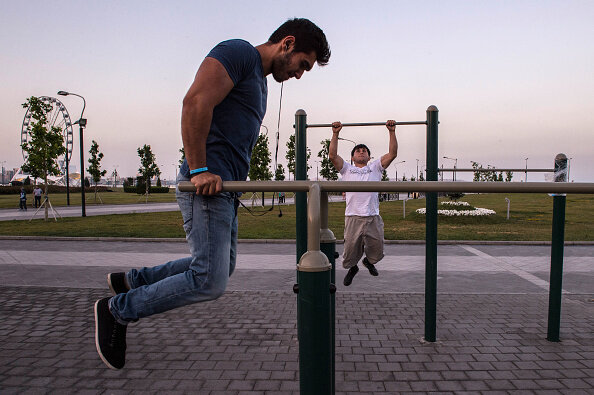In our quest for health and physical well-being, understanding the pivotal role of a robust upper back cannot be overstated. This foundational aspect of our anatomy not only supports our posture but also shields us from the discomfort that can impede our daily activities. Through this journey, we will delve into the essence of fostering a strong and pain-free upper back, unveiling the exercises that stand as pillars for this purpose. Embracing these practices is not merely about enhancing physical appearance; it’s a pathway to a life unmarred by discomfort, where the vitality and freedom of movement are paramount.
Understanding the Importance of a Strong and Pain-Free Upper Back.
The upper back, or the thoracic spine, is a bastion of stability and strength in the human body. Its health is crucial for not only holding us upright but also for ensuring the seamless operation of our shoulders and neck. A robust upper back diminishes the risk of injuries, alleviates chronic pain, and improves our overall quality of life. However, the modern lifestyle, characterized by prolonged periods of sitting and inadequate physical activity, has led to a surge in upper back related discomforts. Recognizing the significance of a strong and pain-free upper back is the first step toward reversing this trend.
Moreover, the muscles of the upper back play an integral role in performing everyday activities with ease. Whether it’s carrying groceries, lifting objects, or even engaging in recreational sports, these muscles are constantly at work. Strengthening them not only enhances our ability to perform these tasks but also shields us from potential strain or injury. Furthermore, a well-conditioned upper back contributes to a poised and confident posture, reflecting a sense of strength and vitality.
Addressing the needs of our upper back through targeted exercises can transform our lives in profound ways. It’s about laying the groundwork for a body that moves with grace and strength, free from the fetters of discomfort. As we venture further into this exploration, the emphasis on exercises for the upper back as a cornerstone for achieving this state becomes increasingly clear.

Common Causes of Upper Back Pain.
Upper back pain, a plight that affects countless individuals, often stems from a confluence of factors rather than a singular cause. Predominant among these is the sedentary lifestyle that has become the hallmark of contemporary society. Hours spent hunched over computers or engrossed in smartphones exert undue stress on the upper back, leading to discomfort and pain. This maladaptive posture, over time, can result in significant strain on the muscles and ligaments of the upper back.
Repetitive strain injuries, another common culprit, arise from performing the same motions over prolonged periods. These injuries are not confined to athletes or those engaged in physical labor; anyone whose activities involve repetitive motions is at risk. The repetitive nature of these tasks can lead to overuse injuries, where the muscles and tendons of the upper back become inflamed, resulting in pain.
Furthermore, improper lifting techniques and inadequate physical conditioning also contribute to upper back pain. Lifting heavy objects without engaging the correct muscles or without the support of a strong upper back can lead to strains and sprains. This underscores the necessity of exercises for the upper back, not only as a remedial measure but also as a preventive strategy.
Benefits of Exercising the Upper Back.
Embarking on a regimen of exercises for the upper back unveils a plethora of benefits that extend beyond mere pain relief. Foremost among these is the enhancement of posture. A strong upper back anchors the spine, promoting an upright posture that exudes confidence and vitality. This alignment is not only aesthetically pleasing but also functional, reducing the strain on the spine and mitigating the risk of chronic pain.
Moreover, exercising the upper back bolsters our functional strength, facilitating the performance of daily tasks and recreational activities with ease. This newfound strength shields us from injuries, allowing us to engage in our favorite activities without the shadow of pain looming over us. Additionally, a robust upper back paves the way for improved performance in sports and exercise, as it is integral to virtually every form of athletic movement.
The psychological benefits of engaging in exercises for the upper back also merit attention. Achieving a pain-free state fosters a sense of well-being, enhancing our overall quality of life. The empowerment that comes from reclaiming control over one’s physical health is transformative, instilling a sense of confidence that permeates every facet of life.
Exercises for the Upper Back Using Dumbbells.
Dumbbells, versatile tools in the realm of fitness, offer a multitude of exercises for the upper back that cater to varying levels of expertise and equipment availability. One foundational exercise is the dumbbell row, a movement that targets the muscles of the upper back with precision. Executing this exercise with proper form involves bending at the hips, keeping the back straight, and drawing the weights upwards towards the chest, mimicking the motion of rowing.
Another pivotal exercise is the reverse fly. This movement, performed by holding dumbbells in each hand and extending the arms out to the sides, engages the rear deltoids along with the upper back. It’s a powerful exercise for combating the forward hunch that arises from prolonged sitting, encouraging the shoulders to roll back and open up.
The dumbbell shrug, though seemingly simple, is profoundly effective in strengthening the trapezius muscles that span the upper back and neck. Lifting the shoulders towards the ears while holding dumbbells, then releasing them back down, works these muscles, fostering strength and resilience in the upper back.

Proper Form and Technique for Dumbbell Exercises.
The maxim “form follows function” holds true in the realm of dumbbell exercises for the back. Adhering to proper form and technique is paramount, not only for maximizing the efficacy of the exercises but also for preventing injuries. When performing dumbbell rows, for instance, maintaining a neutral spine and avoiding excessive rounding or arching of the back ensures that the target muscles are engaged without straining the lower back.
Similarly, during reverse fly exercises, a slight bend in the elbows and a controlled, deliberate movement enhance the engagement of the upper back muscles. Jerky or rapid motions can lead to strains, detracting from the benefits of the exercise. Maintaining a focus on controlled breathing throughout these movements further amplifies their effectiveness, ensuring that the muscles receive ample oxygenation.
In the realm of dumbbell shrugs, the emphasis is on a controlled elevation and descent of the shoulders. Rushing through the movements or using excessively heavy weights can compromise form, leading to ineffective exercise or, worse, injury. The goal is to challenge the muscles through a full range of motion, fostering strength and flexibility in the upper back.
Variations of Dumbbell Exercises for the Upper Back.
To stave off monotony and continuously challenge the upper back, introducing variations to dumbbell exercises is beneficial. One such variation in the dumbbell row involves altering the angle of pull by standing in a staggered stance or using an incline bench. These modifications engage different fibers of the upper back muscles, fostering a more comprehensive strengthening effect.
In the context of reverse fly exercises, incorporating an element of instability, such as performing the movement on a stability ball, enhances the engagement of the core along with the upper back. This holistic approach not only strengthens the target area but also fosters balance and coordination, essential components of physical fitness.
Experimenting with the tempo of exercises, such as incorporating slow eccentric movements or explosive concentric phases, introduces a new dimension of challenge to the muscles. This variability in training stimuli encourages continuous adaptation and growth, ensuring that the benefits of exercising the upper back are fully realized.
Additional Exercises for the Upper Back Without Dumbbells
Diversifying one’s exercise regimen with movements that do not require dumbbells is also instrumental in building a strong and pain-free upper back. Bodyweight exercises, such as the pull-up or its more accessible counterpart, the inverted row, are formidable tools for this purpose. These exercises harness the weight of the body as resistance, challenging the upper back muscles through a natural range of motion.
Incorporating resistance bands into upper back exercises offers another dimension of versatility. Band pull-aparts, for instance, are effective in engaging the rear deltoids and rhomboids, key players in upper back strength. The resistance offered by bands can be adjusted to suit varying levels of strength, making this an accessible exercise for individuals at different stages of their fitness journey.
Yoga and Pilates also contribute valuable exercises for the upper back, emphasizing controlled movements and mindful breathing. Poses such as the cobra or the locust focus on extending the spine and opening the chest, countering the forward hunch and promoting flexibility alongside strength in the upper back.
Stretching and Mobility Exercises for the Upper Back.
Complementing strength exercises with stretching and mobility work is essential for achieving a balanced and pain-free upper back. Stretching exercises, such as the thoracic spine extension over a foam roller, offer relief from stiffness and improve the range of motion. Engaging in such practices regularly not only enhances the benefits of strength exercises but also contributes to overall spinal health.
Mobility exercises, including dynamic stretches and movements that articulate the shoulder blades, foster fluidity and ease of movement in the upper back. These exercises, by promoting the integration of the upper back with the rest of the body, ensure that strength is accompanied by flexibility and functional mobility.
Incorporating these practices into one’s routine not only amplifies the benefits of exercises for the upper back but also lays the foundation for a body that moves with grace and strength, unencumbered by pain or stiffness.

Incorporating Upper Back Exercises into Your Workout Routine.
Integrating exercises for the upper back into one’s workout regimen need not be a daunting task. Starting with two to three exercises, performed in two to three sets of eight to twelve repetitions, can serve as a solid foundation. Gradually increasing the complexity and intensity of the exercises ensures continuous progress.
Moreover, dedicating specific days to focus on the upper back or incorporating these exercises into a comprehensive full-body workout plan can enhance overall physical fitness. Balancing exercises for the upper back with those targeting other muscle groups ensures a holistic approach to strength and wellness.
Listening to one’s body and adjusting the frequency and intensity of exercises is crucial for sustained progress without the risk of injury. This mindful approach to integrating exercises for the upper back fosters a harmonious balance between challenge and recovery, paving the way for a strong and pain-free upper back.
Precautions and Tips for Preventing Injuries During Upper Back Exercises.
While engaging in exercises for the upper back is instrumental in fostering strength and alleviating pain, heed must be paid to preventing injuries. Emphasizing proper form and technique, as discussed earlier, is paramount. Rushing through exercises or using weights that compromise form can lead to strains and sprains, detracting from the benefits of the exercises.
Warming up before diving into intense exercises prepares the muscles for the work ahead, reducing the risk of injury. Incorporating a mix of dynamic stretches and light cardiovascular activity serves as an effective warm-up routine.
Listening to one’s body and respecting its limits is also crucial. Pain or discomfort during exercises serves as a signal to modify the movement or reduce the intensity. Adopting a gradual approach to increasing weights and complexity ensures that the muscles and tendons are not overstressed.
Conclusion
Embarking on a journey to unlock the secrets to a strong and pain-free upper back through effective exercises is a transformative endeavor. The exercises for the upper back delineated in this exploration serve as a beacon for those seeking to enhance their physical well-being. Whether utilizing dumbbells, engaging in bodyweight exercises, or incorporating stretching and mobility work, the path to a robust upper back is multifaceted and rich with potential.
Heeding the precautions and tips for preventing injuries ensures that this journey is not only effective but also safe, allowing us to reap the full spectrum of benefits. Incorporating these exercises into our workout routine, with an emphasis on proper form and technique, lays the groundwork for a body that moves with strength, grace, and freedom from pain.
As we continue to engage in exercises for the upper back, let us remember that this endeavor is not solely about physical transformation. It’s a testament to our resilience, our commitment to self-care, and our pursuit of a life marked by vitality and freedom. Let the strength of our upper back reflect the strength of our resolve, as we stride forth into a future unburdened by discomfort, empowered by our own efforts.


